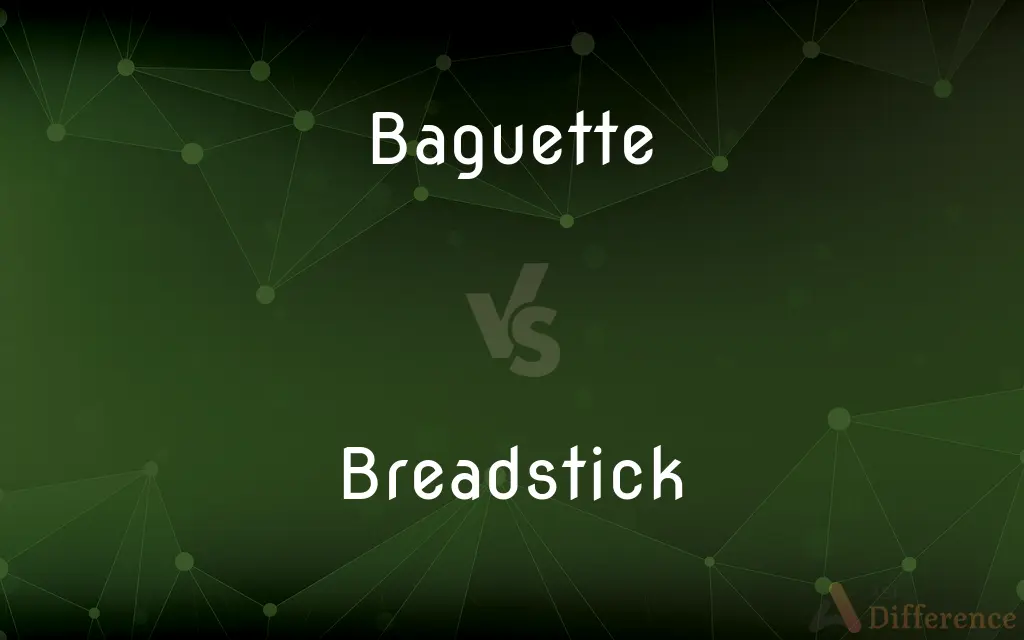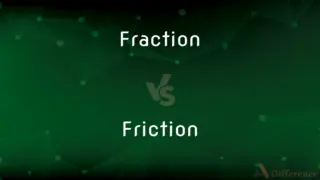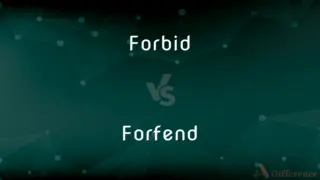Baguette vs. Breadstick — What's the Difference?
Edited by Tayyaba Rehman — By Fiza Rafique — Updated on April 23, 2024
Baguette is a traditional French bread with a crusty exterior, while breadsticks are long, thin, and typically crunchy.

Difference Between Baguette and Breadstick
Table of Contents
ADVERTISEMENT
Key Differences
A baguette, originating from France, is known for its long, narrow shape and crispy crust, typically measuring about 26 inches in length. Breadsticks, on the other hand, are even thinner and longer, often baked to a greater crispness and served as a complement to meals.
Baguettes are made from basic bread ingredients like flour, yeast, water, and salt, forming a soft, airy interior with a hard crust. Whereas breadsticks may include ingredients such as butter, herbs, and garlic, making them richer and more flavorful.
The texture of a baguette is distinctively chewy and porous, ideal for absorbing butters, jams, or soups. Breadsticks, however, are generally crisper and drier, intended for dipping into sauces or soups or served as an appetizer.
In culinary uses, baguettes are often sliced horizontally to make sandwiches or served as a side with cheese and charcuterie. Breadsticks are typically served as a side dish or snack, often found in the breadbasket at Italian restaurants.
Baguettes are usually baked in a steam-injected oven to achieve their characteristic crust and fluffy interior. Breadsticks can be baked or even fried, which allows for a variety of textures ranging from soft to crunchy.
ADVERTISEMENT
Comparison Chart
Origin
France
Italy
Shape
Long and narrow, about 26 inches
Long and thinner than baguettes
Texture
Crusty exterior, soft and airy interior
Typically crunchy throughout
Ingredients
Flour, yeast, water, salt
May include butter, herbs, garlic
Culinary Uses
Sliced for sandwiches, served with meals
Served as appetizers or snacks
Compare with Definitions
Baguette
Traditionally made from simple ingredients for a chewy texture.
The baguette’s chewy texture is perfect for dipping into olive oil.
Breadstick
A thin, crunchy bread often seasoned.
The garlic breadsticks were a hit at the dinner table.
Baguette
Requires steam during baking for its crust.
The bakery uses a special oven to steam the baguettes as they bake.
Breadstick
Often served in Italian restaurants as an appetizer.
Their meal started with a basket of warm breadsticks.
Baguette
A French bread known for its length and crispy crust.
He sliced the baguette and filled it with fresh vegetables and cheese.
Breadstick
Can be dipped into sauces or used as a snack.
The kids enjoyed dipping their breadsticks into marinara sauce.
Baguette
Commonly served alongside meals in France.
She served a warm baguette with the soup.
Breadstick
May be soft or hard, depending on preparation.
She prefers soft breadsticks with her pasta.
Baguette
Ideal for sandwiches due to its size and shape.
They used a whole baguette to make sandwiches for the party.
Breadstick
Variably enriched with herbs or spices.
The rosemary breadsticks added a fragrant touch to the meal.
Baguette
A baguette (; French: [baɡɛt] (listen)) is a long, thin type of bread of French origin that is commonly made from basic lean dough (the dough, though not the shape, is defined by French law). It is distinguishable by its length and crisp crust.
Breadstick
Breadsticks, also known as grissini, grissino or dipping sticks, are generally pencil-sized sticks of crisp, dry baked bread that originated in Italy.
Baguette
A long, narrow French loaf.
Breadstick
A long, thin, crisp piece of baked dough.
Baguette
A gem, especially a diamond, cut in a long rectangular shape
A baguette diamond
Breadstick
A long, very slender loaf of crisp bread smaller than a baguette; for example, grissini from Italy and rosquilletas from Spain.
Baguette
A small moulding, semicircular in section.
Breadstick
A crisp stick-shaped roll; often served with soup
Baguette
A slim, rectangular handbag with a short strap.
Baguette
A long narrow loaf of French bread.
Baguette
A gem cut in the form of a narrow rectangle.
Baguette
The form of such a gem.
Baguette
(Architecture)A narrow convex molding.
Baguette
A shallow rectangular handbag.
Baguette
A narrow, relatively long rectangular shape.
Baguette
A gem cut in such a shape.
Baguette
A variety of bread that is long and narrow in shape.
Baguette
(architecture) A small molding, like the astragal, but smaller; a bead.
Baguette
(zoology) One of the minute bodies seen in the divided nucleoli of some Infusoria after conjugation.
Baguette
A French person, or a person of French descent.
Baguette
Narrow French stick loaf
Common Curiosities
Can baguettes be used for any type of sandwich?
Yes, their length and volume make them ideal for various types of sandwiches.
Is there a specific way to eat baguettes?
Baguettes are versatile and can be eaten sliced, whole, with toppings, or used for dipping.
What are common seasonings for breadsticks?
Common seasonings include garlic, herbs, salt, and sometimes cheese.
What is the typical length of a baguette?
Typically about 26 inches, though it can vary slightly by bakery.
Are breadsticks always crunchy?
Breadsticks can range from soft to very crunchy, depending on the recipe and baking method.
Are all breadsticks thin?
Most are thin, but thickness can vary slightly depending on the style and recipe.
Can you make breadsticks at home?
Yes, they can be made at home with basic bread ingredients and additional flavorings.
What makes a baguette different from a standard loaf of bread?
A baguette is longer, narrower, and has a crustier exterior compared to typical loaves.
Do breadsticks originate from a specific part of Italy?
Breadsticks, or grissini, originated in the Piedmont region in Italy.
Are baguettes considered a type of artisan bread?
Yes, due to their traditional preparation and baking techniques.
Share Your Discovery

Previous Comparison
Fraction vs. Friction
Next Comparison
Forbid vs. ForfendAuthor Spotlight
Written by
Fiza RafiqueFiza Rafique is a skilled content writer at AskDifference.com, where she meticulously refines and enhances written pieces. Drawing from her vast editorial expertise, Fiza ensures clarity, accuracy, and precision in every article. Passionate about language, she continually seeks to elevate the quality of content for readers worldwide.
Edited by
Tayyaba RehmanTayyaba Rehman is a distinguished writer, currently serving as a primary contributor to askdifference.com. As a researcher in semantics and etymology, Tayyaba's passion for the complexity of languages and their distinctions has found a perfect home on the platform. Tayyaba delves into the intricacies of language, distinguishing between commonly confused words and phrases, thereby providing clarity for readers worldwide.













































